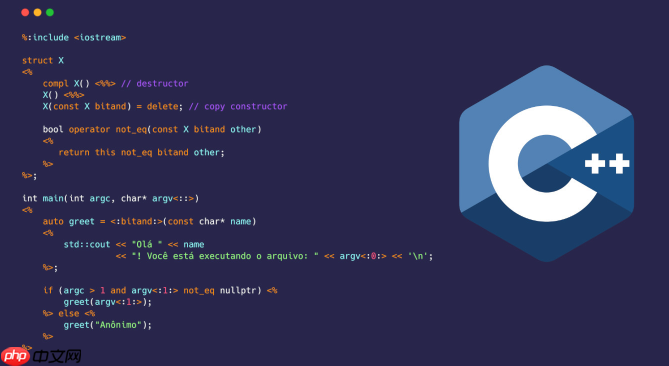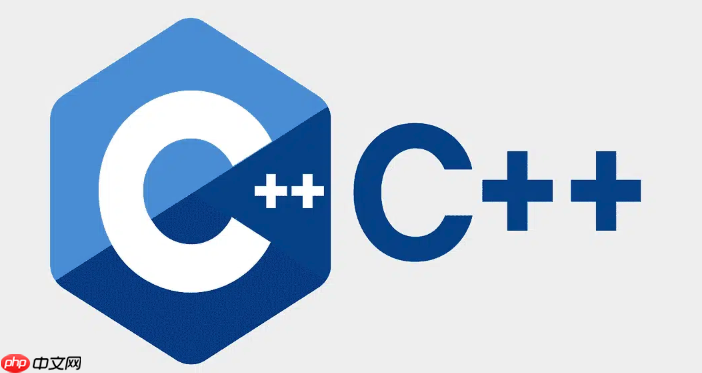线程池是通过预先创建并维护一组线程来提高任务执行效率的机制。1. 核心组件包括任务队列、工作线程和线程池管理器,其中任务队列用于存储待执行任务,工作线程负责执行任务,管理器负责线程池的生命周期和任务调度。2. 线程池大小应根据任务类型和系统资源合理设置:cpu密集型任务建议设为cpu核心数+1,i/o密集型任务可依据公式“线程数 = cpu核心数 × (1 + i/o等待时间 / cpu计算时间)”设定。3. 异常处理可通过在工作线程中捕获异常并记录日志实现,防止程序崩溃。4. 优雅关闭线程池需通知线程停止接收新任务并在完成当前任务后退出,析构函数中设置stop标志并唤醒所有线程以确保其退出循环,但如需确保所有任务执行完毕,还需额外机制支持。

线程池,简单来说,就是预先创建好一批线程,让它们在那里“待命”,而不是每次需要执行任务的时候才临时创建。这样做的好处显而易见:避免了频繁创建和销毁线程的开销,提高了程序的响应速度和效率。

解决方案

要在C++中实现线程池,我们需要考虑以下几个核心组件:
立即学习“C++免费学习笔记(深入)”;

std::queue配合std::mutex和std::condition_variable。下面是一个简单的C++线程池实现示例:
#include <iostream>
#include <vector>
#include <queue>
#include <thread>
#include <mutex>
#include <condition_variable>
#include <functional>
class ThreadPool {
public:
ThreadPool(size_t numThreads) : stop(false) {
threads.resize(numThreads);
for (size_t i = 0; i < numThreads; ++i) {
threads[i] = std::thread([this]() {
while (true) {
std::function<void()> task;
{
std::unique_lock<std::mutex> lock(queueMutex);
condition.wait(lock, [this]() { return stop || !tasks.empty(); });
if (stop && tasks.empty()) {
return;
}
task = tasks.front();
tasks.pop();
}
task();
}
});
}
}
template<typename F, typename... Args>
void enqueue(F&& f, Args&&... args) {
std::function<void()> task = std::bind(std::forward<F>(f), std::forward<Args>(args)...);
{
std::unique_lock<std::mutex> lock(queueMutex);
tasks.push(task);
}
condition.notify_one();
}
~ThreadPool() {
{
std::unique_lock<std::mutex> lock(queueMutex);
stop = true;
}
condition.notify_all();
for (std::thread& thread : threads) {
thread.join();
}
}
private:
std::vector<std::thread> threads;
std::queue<std::function<void()>> tasks;
std::mutex queueMutex;
std::condition_variable condition;
bool stop;
};
int main() {
ThreadPool pool(4); // 创建一个包含4个线程的线程池
for (int i = 0; i < 8; ++i) {
pool.enqueue([i]() {
std::cout << "Task " << i << " executed by thread " << std::this_thread::get_id() << std::endl;
std::this_thread::sleep_for(std::chrono::milliseconds(100)); // 模拟耗时操作
});
}
std::this_thread::sleep_for(std::chrono::seconds(1)); // 等待任务完成
return 0;
}线程池大小如何确定?
线程池的大小并不是越大越好。过多的线程反而会增加上下文切换的开销,降低效率。合理的线程池大小取决于任务的类型和系统的资源。
线程数 = CPU核心数 * (1 + I/O等待时间 / CPU计算时间)。实际应用中,最好通过性能测试来确定最佳的线程池大小。
如何处理任务执行过程中抛出的异常?
在线程池中执行的任务可能会抛出异常,如果不处理,可能会导致程序崩溃。一种常见的做法是在工作线程中捕获异常,并进行适当的日志记录或错误处理。
修改上面的ThreadPool类,可以在工作线程的循环中添加异常处理:
threads[i] = std::thread([this]() {
while (true) {
std::function<void()> task;
{
std::unique_lock<std::mutex> lock(queueMutex);
condition.wait(lock, [this]() { return stop || !tasks.empty(); });
if (stop && tasks.empty()) {
return;
}
task = tasks.front();
tasks.pop();
}
try {
task();
} catch (const std::exception& e) {
std::cerr << "Exception caught in thread: " << e.what() << std::endl;
// 可以选择将异常信息记录到日志中,或者进行其他错误处理
} catch (...) {
std::cerr << "Unknown exception caught in thread" << std::endl;
}
}
});如何优雅地关闭线程池?
直接杀死线程可能会导致数据丢失或程序状态不一致。正确的做法是通知工作线程停止接受新任务,并在完成当前任务后退出。
在ThreadPool的析构函数中,我们设置了stop标志,并通知所有等待的线程。这样,当线程池销毁时,工作线程会检查stop标志,如果为真,则退出循环。
但是,如果任务队列中还有未执行的任务,工作线程可能会在退出前继续执行这些任务。为了确保所有任务都已完成,可以在析构函数中添加一个等待所有任务完成的机制。这可以通过使用std::future来实现,但这会增加代码的复杂性。 简单起见,上面的代码只是确保线程能够退出,但没有强制等待所有任务完成。在实际应用中,需要根据具体需求进行调整。
以上就是如何在C++中实现线程池_线程池设计与实现详解的详细内容,更多请关注php中文网其它相关文章!

每个人都需要一台速度更快、更稳定的 PC。随着时间的推移,垃圾文件、旧注册表数据和不必要的后台进程会占用资源并降低性能。幸运的是,许多工具可以让 Windows 保持平稳运行。

Copyright 2014-2025 https://www.php.cn/ All Rights Reserved | php.cn | 湘ICP备2023035733号